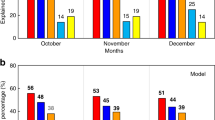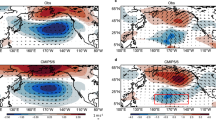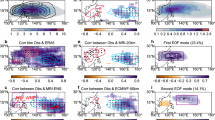Abstract
El Niño/Southern Oscillation, the dominant mode of interannual climate variability, strongly influences tropical cyclone activity. During canonical El Niño, the warm phase, Atlantic tropical cyclones are suppressed. However, the past decades have witnessed different El Niño characteristics, ranging from warming over the east Pacific cold tongue in canonical events to warming near the warm pool, known as warm pool El Niño or central Pacific El Niño. Global climate models project possible future increases in intensity of warm pool El Niño. Here we use a climate model at a resolution sufficient to explicitly simulate tropical cyclones to investigate how these flavours of El Niño may affect such cyclones. We show that Atlantic tropical cyclones are suppressed regardless of El Niño type. For the warmest 10% of each El Niño flavour, warm pool El Niño is substantially less effective at suppressing Atlantic tropical cyclones than cold tongue El Niño. However, for the same absolute warming intensity, the opposite is true. This is because less warming is required near the warm pool to satisfy the sea surface temperature threshold for deep convection, which leads to tropical cyclone suppression through vertical wind shear enhancements. We conclude that an understanding of future changes in not only location, but also intensity and frequency, of El Niño is important for forecasts and projections of Atlantic tropical cyclone activity.
This is a preview of subscription content, access via your institution
Access options
Subscribe to this journal
Receive 12 print issues and online access
$259.00 per year
only $21.58 per issue
Buy this article
- Purchase on Springer Link
- Instant access to full article PDF
Prices may be subject to local taxes which are calculated during checkout





Similar content being viewed by others
References
Bove, M. C., O’Brien, J. J., Elsner, J. B., Landsea, C. W. & Niu, X. Effect of El Niño on U.S. landfalling hurricanes, revisited. Bull. Am. Meteorol. Soc. 79, 2477–2482 (1998).
Pielke, R. A. Jr & Landsea, C. W. La Niña, El Niño, and Atlantic hurricane damages in the United States. Bull. Am. Meteorol. Soc. 80, 2027–2033 (1999).
Smith, S. R., Brolley, J., O’Brien, J. J. & Tartaglione, C. A. ENSO’s impact on regional U.S. hurricane activity. J. Clim. 20, 1404–1414 (2007).
Arkin, P. A. The relationship between interannual variability in the 200 mb tropical wind field and the Southern Oscillation. Mon. Weath. Rev. 110, 1393–1404 (1982).
Gray, W. M. Atlantic seasonal hurricane frequency. Part I: El Niño and 30 mb quasi-biennial oscillation influences. Mon. Weath. Rev. 112, 1649–1668 (1984).
Goldenberg, S. B. & Shapiro, L. J. Physical mechanisms for the association of El Niño and West African rainfall with Atlantic major hurricane activity. J. Clim. 9, 1169–1187 (1996).
Gray, W. M. Global view of the origin of tropical disturbances and storms. Mon. Weath. Rev. 96, 669–700 (1968).
Frank, W. M. & Ritchie, E. A. Effects of vertical wind shear on the intensity and structure of numerically simulated hurricanes. Mon. Weath. Rev. 129, 2249–2269 (2001).
Gallina, G. M. & Velden, C. S. Environmental vertical wind shear and tropical cyclone intensity change utilizing enhanced satellite derived wind information. In 25th Conference on Hurricanes and Tropical Meteorology 172–173 (Am. Meteorol. Soc., 2002).
Wong, M. L. M. & Chan, J. C. L. Tropical cyclone intensity in vertical wind shear. J. Atmos. Sci. 61, 1859–1876 (2004).
Tang, B. H. & Neelin, J. D. ENSO influence on Atlantic hurricanes via tropospheric warming. Geophys. Res. Lett. 31, L24204 (2004).
Ashok, K., Behera, S. K., Rao, S. A., Weng, H. & Yamagata, T. El Niño Modoki and its possible teleconnection. J. Geophys. Res. 112, C11007 (2007).
Kug, J.-S., Jin, F.-F. & An, S.-I. Two types of El Niño events: cold tongue El Niño and warm pool El Niño. J. Clim. 22, 1499–1515 (2009).
Lee, T. & McPhaden, M. J. Increasing intensity of El Niño in the central-equatorial Pacific. Geophys. Res. Lett. 37, L14603 (2010).
Takahashi, K., Montecinos, A., Goubanova, K. & Dewitte, B. ENSO regimes: reinterpreting the canonical and Modoki El Niño. Geophys. Res. Lett. 38, L10704 (2011).
Kim, H.-M., Webster, P. J. & Curry, J. A. Impact of shifting patterns of Pacific ocean warming on North Atlantic tropical cyclones. Science 325, 77–80 (2009).
Lee, S.-K., Wang, C. & Enfield, D. B. On the impact of central Pacific warming events on Atlantic tropical storm activity. Geophys. Res. Lett. 37, L17702 (2010).
Larson, S., Lee, S.-K., Wang, C., Chung, E.-S. & Enfield, D. B. Impacts of non-canonical El Niño patterns on Atlantic hurricane activity. Geophys. Res. Lett. 39, L14706 (2012).
Wang, H. et al. How well do global climate models simulate the variability of Atlantic tropical cyclones associated with ENSO? J. Clim. 27, 5673–5692 (2014).
Yeh, S.-W. et al. El Niño in a changing climate. Nature 461, 511–514 (2009).
Kim, S. T. & Yu, J.-Y. The two types of ENSO in CMIP5 models. Geophys. Res. Lett. 39, L11704 (2012).
Skamarock, W. C. et al. A Description of the Advanced Research WRF Version 3 NCAR/TN–475+STR (2008); http://dx.doi.org/10.5065/D68S4MVH.
Rayner, N. A. et al. Global analyses of sea surface temperature, sea ice, and night marine air temperature since the late nineteenth century. J. Geophys. Res. 108, 4407 (2003).
Wang, C. & Lee, S.-K. Co-variability of tropical cyclones in the North Atlantic and the eastern North Pacific. Geophys. Res. Lett. 36, L24702 (2009).
Bell, G. D. et al. Climate Assessment for 1999. Bull. Am. Meteorol. Soc. 81, s1–s50 (2000).
Williams, I. N., Pierrehumbert, R. T. & Huber, M. Global warming, convective threshold and false thermostats. Geophys. Res. Lett. 36, L21805 (2009).
Gadgil, S., Joseph, P. V. & Joshi, N. V. Ocean–atmosphere coupling over monsoon regions. Nature 312, 141–143 (1984).
Graham, N. E. & Barnett, T. P. Sea surface temperature, surface wind divergence, and convection over tropical oceans. Science 238, 657–659 (1987).
Zhang, C. Large-scale variability of atmospheric deep convection in relation to sea surface temperature in the tropics. J. Clim. 6, 1898–1913 (1993).
Waliser, D. E., Graham, N. E. & Gautier, C. Comparison of the highly reflective cloud and outgoing longwave radiation datasets for use in estimating tropical deep convection. J. Clim. 6, 331–353 (1993).
Sabin, T. P., Babu, C. A. & Joseph, P. V. SST–convection relation over tropical oceans. Int. J. Climatol. 33, 1424–1435 (2013).
Emanuel, K. A. & Nolan, D. Tropical cyclone activity and global climate. In 26th Conference on Hurricanes and Tropical Meteorology 240–241 (Am. Meteorol. Soc., 2004).
Johnson, N. C. & Xie, S.-P. Changes in the sea surface temperature threshold for tropical convection. Nature Geosci. 3, 842–845 (2010).
Evans, J. L. & Waters, J. J. Simulated relationships between sea surface temperatures and tropical convection in climate models and their implications for tropical cyclone activity. J. Clim. 25, 7884–7895 (2012).
Simpson, R. & Riehl, R. Mid-tropospheric ventilation as a constraint on hurricane development and maintenance. Preprints, Tech. Conf. on Hurricanes, Miami Beach, FL, Am. Meteorol. Soc. D4-1–D4-10 (1958).
Tang, B. & Emanuel, K. Midlevel ventilation’s constraint on tropical cyclone intensity. J. Atmos. Sci. 67, 1817–1830 (2010).
Patricola, C. M., Saravanan, R. & Chang, P. The impact of the El Niño–Southern Oscillation and Atlantic meridional mode on seasonal Atlantic tropical cyclone activity. J. Clim. 27, 5311–5328 (2014).
Landsea, C. W., Pielke, R. A. Jr & Mestas-Nuñez, A. M. Atlantic basin hurricanes: indices of climate change. Climatic Change 42, 89–129 (1999).
Goldenberg, S. B., Landsea, C. W., Mestas-Nuñez, A. M. & Gray, W. M. The recent increase in Atlantic hurricane activity: causes and implications. Science 293, 474–479 (2001).
Vitart, F. & Anderson, J. L. Sensitivity of Atlantic tropical storm frequency to ENSO and interdecadal variability of SSTs in an ensemble of AGCM integrations. J. Clim. 14, 533–545 (2001).
Webster, P. J., Holland, G. J., Curry, J. A. & Chang, H.-R. Changes in tropical cyclone number, duration, and intensity in a warming environment. Science 309, 1844–1846 (2005).
Bell, G. D. & Chelliah, M. Leading tropical modes associated with interannual and multidecadal fluctuations in North Atlantic hurricane activity. J. Clim. 19, 590–612 (2006).
Kossin, J. P. & Vimont, D. J. A more general framework for understanding Atlantic hurricane variability and trends. Bull. Am. Meteorol. Soc. 88, 1767–1781 (2007).
Klotzbach, P. J. The influence of El Niño–Southern Oscillation and the Atlantic Multidecadal Oscillation on Caribbean tropical cyclone activity. J. Clim. 24, 721–731 (2011).
Kanamitsu, M. et al. NCEP-DOE AMIP-II Reanalysis (R-2). Bull. Am. Meteorol. Soc. 83, 1631–1643 (2002).
Walsh, K. Objective detection of tropical cyclones in high-resolution analyses. Mon. Weath. Rev. 125, 1767–1779 (1997).
Emanuel, K. A sensitivity of tropical cyclones to surface exchange coefficients and a revised steady-state model incorporating eye dynamics. J. Atmos. Sci. 52, 3969–3976 (1995).
Bister, M. & Emanuel, K. A. Low frequency variability of tropical cyclone potential intensity. 1. Interannual to interdecadal variability. J. Geophys. Res. 107, 4801 (2002).
Camargo, S. J., Emanuel, K. A. & Sobel, A. H. Use of a genesis potential index to diagnose ENSO effects on tropical cyclone genesis. J. Clim. 20, 4819–4834 (2007).
Landsea, C. W. & Franklin, J. L. Atlantic hurricane database uncertainty and presentation of a new database format. Mon. Weath. Rev. 141, 3576–3592 (2013).
Schade, L. R. & Emanuel, K. A. The ocean’s effect on the intensity of tropical cyclones: results from a simple coupled atmosphere–ocean model. J. Atmos. Sci. 56, 642–651 (1999).
Kalnay, E. et al. The NCEP/NCAR 40-year reanalysis project. Bull. Am. Meteorol. Soc. 77, 437–470 (1996).
Adler, R. F. et al. The version 2 global precipitation climatology project (GPCP) monthly precipitation analysis (1979-present). J. Hydrometeorol. 4, 1147–1167 (2003).
Acknowledgements
This research was supported by US National Science Foundation Grant AGS-1347808 and used the Extreme Science and Engineering Discovery Environment (XSEDE), which is supported by National Science Foundation Grant ACI-1053575. P.C. acknowledges the support from the National Program on Key Basic Research Project (973 Program) no. 2013CB956204 and no. 2014CB745000. High-performance computing resources were provided by the Texas Advanced Computing Center (TACC) at The University of Texas at Austin and by the Texas A&M Supercomputing Facility.
Author information
Authors and Affiliations
Contributions
All authors contributed to designing the project, interpreting the results, and improving the paper. C.M.P. carried out the model simulations and analysis and wrote the paper.
Corresponding author
Ethics declarations
Competing interests
The authors declare no competing financial interests.
Supplementary information
Supplementary Information
Supplementary Information (PDF 2143 kb)
Rights and permissions
About this article
Cite this article
Patricola, C., Chang, P. & Saravanan, R. Degree of simulated suppression of Atlantic tropical cyclones modulated by flavour of El Niño. Nature Geosci 9, 155–160 (2016). https://doi.org/10.1038/ngeo2624
Received:
Accepted:
Published:
Issue Date:
DOI: https://doi.org/10.1038/ngeo2624



